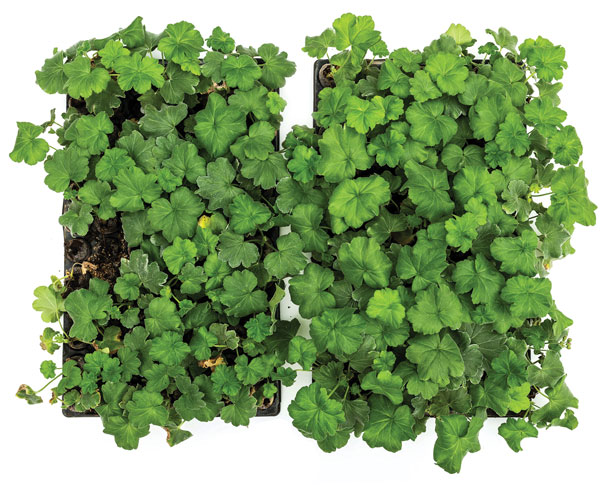4/1/2019
Syngenta Partners with Post-Harvest Expert OptiFreeze
Chris Beytes

As an industry, we talk a lot about post-harvest life of flowers, especially cuts and potted plants. But what about technology to extend the life of unrooted cuttings and young plants?
The Swedish company OptiFreeze says they have a technology that will do just that, which is why Syngenta Flowers has signed a collaboration agreement with them to test and develop it further. The venture was announced February 19.
OptiFreeze is a start-up company from Lund University that has developed a patented process (of the same name) that enhances the taste, shape and texture of fruit and vegetables throughout the freezing and thawing process. They’ve also got technology for improving the shelf life of fresh cut fruit and vegetables (OptiFresh) and dried herbs (OptiDry).
Pictured: Pelargonium treated (on the right) and control cuttings were stored seven days after treatment and planted.
What Syngenta is interested in is OptiCept, which has been proven to extend the useful life of a geranium cutting from four days to 11 days, as they learned in testing that began back in July 2017. This can help with the challenge of shipping cuttings from Africa and Latin America into Europe and North America, and keeping them fresh and viable for customers to root. Tests showed promise not only for pelargonium, but also other ornamental crops, including dipladenia, lavendula and argyranthemum.
Syngenta Flowers’ Innovation Manager Josef Fischer says, “We are impressed by OptiFreeze’s invention and believe this breakthrough technology will improve the quality of unrooted cuttings and young plants for our customers. The improved shelf life of nearly two weeks enables much better planning and handling of our products with a more predictable supply to grower’s sites. The combination of improved quality, better storability and transportability of unrooted cuttings is really exciting, as it allows the industry to deliver better products more reliably and reduce waste significantly.”
Syngenta plans on installing an industrial-scale application line at their Kenya farm, which produces more than 100 million cuttings per year. They’ll do pre-commercial testing later this year, with the first commercial use for the 2019/2020 cutting shipping season.
If the technology is as promising as they tout, will they share? Yes, they answer, via a licensing model.
Göran Hedbys, Chairman of the Board of OptiFreeze, says, “Syngenta Flowers is a perfect partner with the market insights that we are missing. We will also get some muscles behind us for the next step when making the technology an industrial standard. Step-by-step we are discovering the potential this technology has and by combining our forces we will take a huge leap forward.”
How’s it work?
For what it’s worth, here’s how OptiFreeze describes its system: “The OptiFreeze technology consists of two steps: Vacuum Infusion (VI) and Pulsed Electric Field (PEF). These two steps allow impregnation of liquids into plant cells, without damaging the plant tissues. By this technology, the life expectancy of flower cuttings is increased dramatically. It also has a positive effect on the rooting speed and growth after transportation, resulting in stronger plants. The improved shelf life can bring efficiency at the farm, improved logistics, gives a better quality at the grower and extra value to the plant.” GT